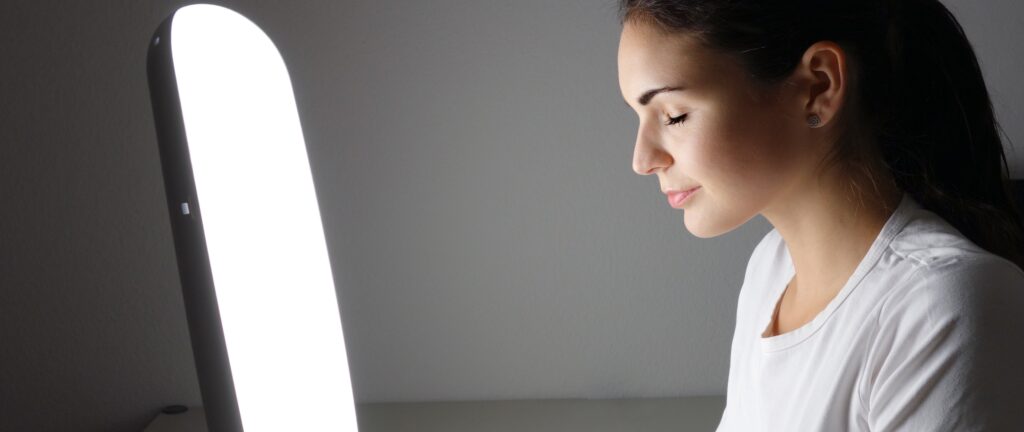‘Tis the season…for winter doldrums. And with the festive holiday season over now, we’re really in it until the days begin to grow perceptibly longer and the temperature warms up toward springtime.
We’ve covered a few angles about how light is such an important factor for our health. Check out these previous blog posts:
- Healthy Sleep Series: Melatonin teaches us about our master hormone and offers some natural solutions.
- Illuminating the Link Between Blue Light and Sleep helps us understand how blue light from our devices and household lighting can be disruptive to sleep, and what to do to reduce the impact.
- Shining a Light on Red Light Therapy introduces us to the amazing benefits of red light, including better sleep!
But there’s an elephant in the room…and that’s Seasonal Affective Disorder with its apt acronym SAD. So let’s learn more.

What is Seasonal Affective Disorder and Who Experiences It?
SAD is a type of major depression that appears cyclically, arriving in the Fall and spontaneously disappearing in the Spring. All the hallmarks of depression are present: sad feelings, irritable mood, lack of focus, low energy, social isolation, and eating and sleeping more than usual. While it’s more common in the north, it can happen where it’s sunnier too, like the desert Southwest or Florida. And it affects women at a greater rate than men—three times greater.
That being said, only around three percent of the population experiences SAD. In order to qualify as an official diagnosis, one must present with at least five of nine clinical symptoms for at least a two week period. If not, you may have a case of winter blues, which is similar but not as severe. Luckily, in both cases, there are plenty of lifestyle tweaks that can help.

Understanding Our Circadian Rhythms
Given how crucial our circadian rhythms are to our health, it’s a bit astonishing that we’re not taught more about it. Our bodies are attuned to the cycles of day and night, and so many of our bodily functions run on this clock. In particular, exposure to early morning light helps set the tone for the rest of the day and night, regulating our cortisol and melatonin. Unfortunately, there is much about modern life that interferes with this important system. Most of us aren’t watching the rising sun and we spend way too much time indoors under artificial light.
So what can we do?
- All the usual healthy advice applies. Keep up with your usual health regimens as much as possible: healthy nutrition, exercise, and social interaction. Do your best to maintain a consistent sleep schedule, getting to bed at a decent time (not too late!) and wake up early enough for early morning light. Limit caffeine and alcohol.
- Avoid artificial light at night. Both device screens and indoor light bulbs emit blue light wavelengths that prevent proper melatonin production. Check out our post on blue light for more on that.
- Get that early morning light. Aim for 30 minutes after sunrise. It’s also helpful to view sunsets as well. If you haven’t heard Dr. Andrew Huberman preach on this yet, give his popular podcast a listen.
- Try a light box. Research and anecdotal evidence both show that 10,000-lux light boxes used for 30-45 minutes a day around sunrise can ease SAD symptoms. These are unregulated and in tests not all lamps are effective, so be sure to look for third-party certifications and independent testing.
- Try red light therapy. Red light therapy has also shown to be effective for SAD, plus it has more benefits than a typical light box. Check out our post on red light for more on that.
- Consider psychotherapy. There’s evidence to suggest that therapy in conjunction with light therapy can be the best combo for SAD sufferers, especially cognitive behavioral therapy.

Bringing Light to Winter
If you’re someone who experiences winter blues or full-on SAD, hopefully you don’t have to dread winter anymore. With some simple consistent practices, SAD doesn’t have to be…well…so sad. And taking care of yourself is always a win-win.
Thanks so much for reading! For more healthy sleep and lifestyle news, be sure to follow us on Instagram and Pinterest. And as always—sweet dreams!
THIS ARTICLE DOES NOT PROVIDE MEDICAL ADVICE
The information in this article, including but not limited to text, graphics, images, and other materials, are for informational and educational purposes only. No material here is intended as a substitute for professional medical advice, diagnosis, or treatment. Please consult your physician or other qualified health care practitioner with any questions or concerns you may have for your care.

